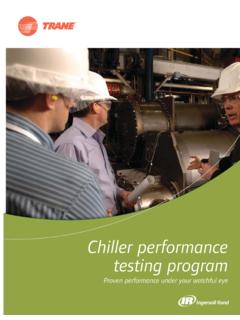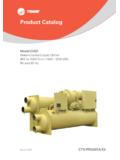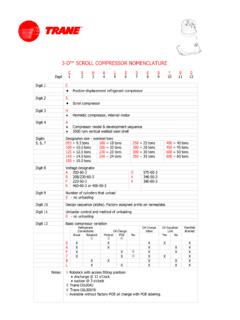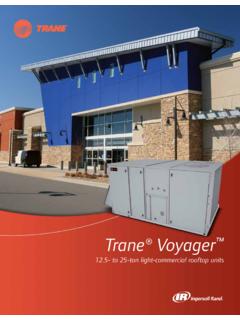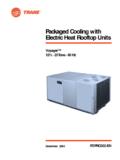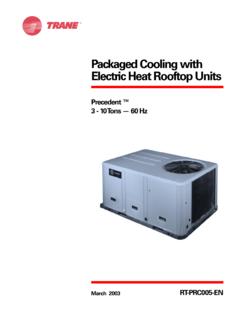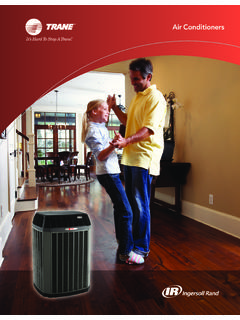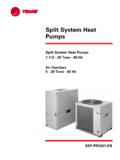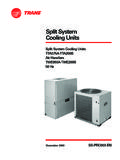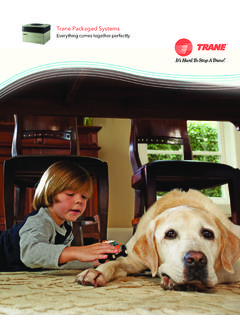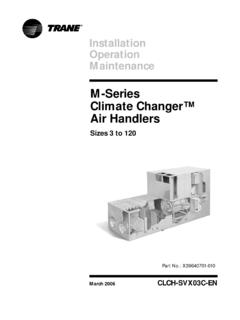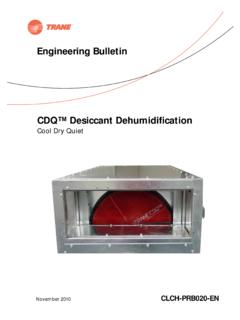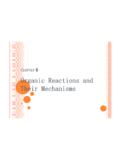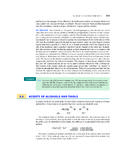Transcription of M-Series and T-Series Climate Changer™ Air Handlers
1 December 2001 clch -PRC008-ENM- series and T-Series Climate changer Air HandlersFan Performance Data for Unit Sizes 3 to 30 See clch -PRC004-EN for features and benefits and clch -PRC003-EN for unit data for unit sizes 3 30. See clch -DS-7 for unit data and clch -CS-7A and clch -CS-7C for fan performance data for all other unit sizes. 2 clch -PRC008-EN 2001 American Standard Inc. All rights reservedThis catalog provides fan curves and performance tables for Trane M-Series and T-Series Climate changer air Handlers , sizes 3 to 30. Trane air Handlers feature greater flexibility through fan optimization and are available with forward-curved, backward-curved, airfoil, and vaneaxial the correct fan, an air-handling unit can operate more efficiently, resulting in consid-erable dollar savings over the life of the unit.
2 Furthermore, fan optimization may provide first cost savings by allowing you to select a fan at a lower price or a smaller motor and CertificationM- series and T-Series air-handling performance data is certified in accordance with ARI Standard 430. Air Handlers with Q fans or plenum fans are outside the scope of ARI Standard certification enables consulting engineers to compare various manufacturers on an equal basis and to select with confidence a fan that will perform as cataloged. Lower system first cost can be achieved without sacri-ficing performance because excessive safety factors are no longer ARI standard requires the fan to be tested along with the largest cataloged face-area coil mounted in its most restrictive position.
3 Because the units are tested as complete units, correction factors for fan performance need not be applied to the inlet of the fan (Figure 1). However, on draw-thru units, fan discharge conditions can be affected by the nature of the discharge ductwork used. The ARI ratings are based on a minimum of three diameters of straight duct from the fan outlet. Consequently, correction factors should be applied, if warranted, for velocity pressure loss due to actual instal-lation conditions. Suggested correction factors are provided on page certified performance rating of the unit with inlet guide vanes is based on a wide-open position of the vanes only. Ratings at other than wide-open position of the vanes are not within the scope of ARI Standard 1.
4 Fan performanceIntroductionCLCH-PRC008-EN3 IntroductionARI Certification .. 2 Application ConsiderationsBasic Fan Selection .. 4 Fan Operation .. 4 VAV System Operation .. 5 Fan-Speed Control .. 6 Inlet Vanes .. 6 Air Density Corrections .. 7 Effect of Fan and Motor Heat .. 7 Effect of Belt-Drive Losses ..7 Blow-Thru Applications .. 8 Draw-Thru Applications .. 8 Vertical Draw-Thru Applications .. 8 Draw-Thru, Blow-Thru, and Ductwork Kt Corrections .. 8 Acoustical Considerations ..10 Additional References ..10 Computer Selection Programs ..11 Using the Fan Curves ..11 Without Inlet VanesBlow-Thru ..14 Horizontal Draw-Thru ..98 Vertical Draw-Thru ..193 Vertical Draw-Thru.
5 263 Contents4 clch -PRC008-ENBasic Fan SelectionTrane Climate changer fan modules can be customized for a specific application using a wide range of fan types and sizes. Available fan types include forward-curved (FC), airfoil (AF), backward-curved (BC), plenum (unhoused AF, or plug ), and the horizontal or vertical vaneaxial fan, such as the Trane Q fan. Base your selection of the fan type and size on the fan airflow (cfm), Total Static Pressure (TSP), efficiency (bhp), operating range, and sound level. Climate changer fan curves show fan cfm, TSP, fan rpm, and fan wide-open cfm (WOCFM) perfor-mance relationships with the fan in the module. The effect of the air handler casing on fan perfor-mance is included in the fan curve.
6 To confirm this fact, check for ARI 430 certification emblems on the catalog and the rpm line is the output of the fan (Figure 1). WOCFM lines represent equal percentages of the fan maximum airflow (the inter-section of the rpm line and the zero static axis). The fan design operating point on the fan curve is always to the right of the surge area. For the lowest sound and the best fan efficiency, FC fans are generally selected around 40 percent to 70 percent WOCFM and all other fans around 60 percent to 80 percent fan curves represent fan performance with standard air (sea-level pressure, 70 F) and three diameters of straight duct on the fan outlet for draw-thru fans or a large discharge plenum on the fan outlet for blow-thru fans.
7 If the fan is to be used with non-standard altitude, air temperature, or ductwork, you must manually correct for such conditions (see the Air Density Corrections section on page 7) when using these fan curves. The Trane Official Product Selection System (TOPSS program) for M-Series and T-Series air Handlers automatically makes the necessary adjustments based on the project OperationThe air-handling system (ductwork, coils, filters, and dampers) follows a squared system curve that goes through the 0 cfm, 0 TSP origin. It parallels the WOCFM lines (Figure 2). Inter-section of the fan rpm line and the squared system curve is the point of system can have a significant effect on this operating point.
8 If the system curve is selected for dirty filters, the fan will deliver more air with clean filters (Figure 3). If the system is selected for clean filters, the fan will deliver less air with dirty filters. Fans with steep rpm Figure 1. Typical fan curveFigure 2. Fan operation: squared system curveFigure 3. Effect of filters on RPM selectionApplication ConsiderationsCLCH-PRC008-EN5lines have less variation in airflow as the system static pressure changes. Selecting the operation point with filter mid-life pressure drop is a good compromise if the fan is a constant-volume fan, but constant airflow is not always required. If a constant airflow is always required, select the fan for dirty filter static pressure and design airflow.
9 Add a variable-air-volume (VAV) modulation device to the fan to maintain the constant System OperationVAV systems offer substantial fan energy savings because the fan delivers block, not peak, airflow to the building. VAV systems develop a VAV system modulation curve (see Figure 4). This curve extends from the VAV duct static control point to the design, full-load operating point. As VAV terminal boxes close and open, the air delivery of the fan modulates along this VAV system curve (by inlet vanes or fan-speed adjustment) until the constant static pressure sensor in the system ductwork is satisfied. The shape of the VAV system modulation curve is independent of the modulation method.
10 It depends only on the static pressure control Climate changer fan can be safely modulated along the VAV system curve by the VAV device and into the surge area as long as this occurs below in. wg. Below in. wg, the amount of energy in the fan is very low and will not cause noise or mechanical problems. See the Inlet Vanes section on page 6 for more addition, the VAV system curve must be low enough that the rpm curve and the VAV system curve always diverge as the airflow goes down (Figure 5). This ensures stable, non-hunting operation. Note the FC fan, with its flat fan rpm lines, is well-suited to low-pressure, VAV system 6 shows a Q fan with a VAV system curve too close to the surge area.
